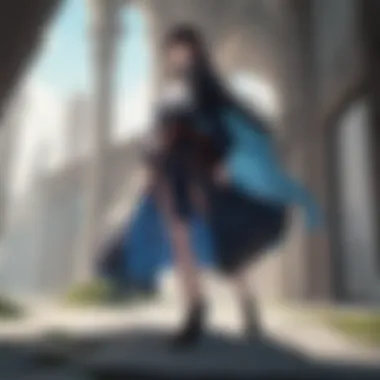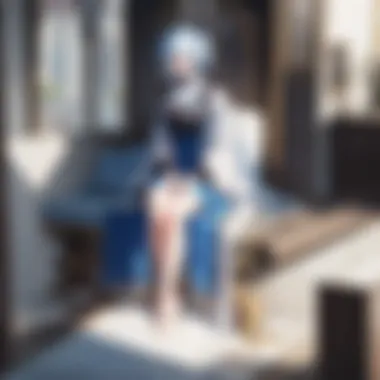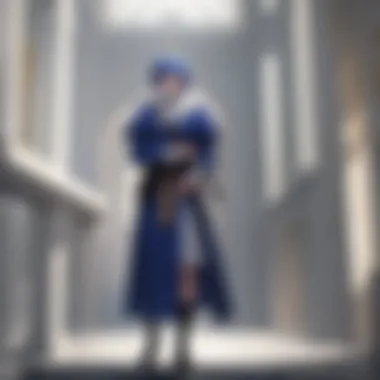The Reconstruction of a Realm: Analyzing a Realist Hero


Intro
In the world of anime and manga, stories often transport viewers to realms where magic, politics, and morality intertwine. How a Realist Hero Rebuilt the Kingdom stands out as a series that merges these elements, particularly through its protagonist's pragmatic approach to rule. This article aims to explore the English dubbed version of the series, delving into the narrative structure, thematic depth, and character development. It examines how the protagonist transforms a kingdom facing dire straits into a thriving state by applying principles grounded in realism.
The nuances present in the English dub add layers to the narrative, prompting viewers to reassess the socio-political ramifications of the hero's strategies. This discussion aims to appeal to anime and manga enthusiasts who seek a comprehensive understanding of the series and its characters. By analyzing these aspects, the article emphasizes the importance of realism in fantasy storytelling, ultimately enhancing appreciation for intricate narratives.
Featured Series or Manga
Overview of the Series
How a Realist Hero Rebuilt the Kingdom illustrates a unique fusion of fantasy and realistic governance. At its core, the narrative follows Kazuya Souma, a modern-day university student unexpectedly summoned to a medieval world. Instead of relying on magical powers or heroic bravado, Kazuya adopts a rational mindset, implementing policies aimed at stabilizing and revitalizing the kingdom of Elfrieden. The series invites viewers to witness the impact of practical governance on societal structures—a noteworthy deviation from typical fantasy tropes.
Key Characters and Development
The narrative features a rich tapestry of characters who influence and are influenced by Kazuya's journey. Key figures include Liscia Elfrieden, the crown princess deeply committed to her people; and the council of advisors who represent various factions within the kingdom. Each character adds depth to the storyline, allowing the audience to explore their motivations and transformations in response to Kazuya's leadership. The interplays between these characters and Kazuya illuminate themes of politics, governance, and interpersonal relationships.
Character Analysis
Major Characters
- Kazuya Souma: The protagonist known for his analytical skills and modern perspectives on governance.
- Liscia Elfrieden: The determined princess who balances duty with personal desires.
- Carmen: An experienced advisor whose wisdom guides crucial decisions.
Character Arcs and Growth
Throughout the series, characters undergo significant transformations. Kazuya evolves from a passive participant in his new reality to an engaged leader who takes actionable steps towards reform. Liscia, initially portrayed as a supportive figure, grows into a formidable political player, showcasing her capability to adapt alongside Kazuya. Their parallel growth resonates with viewers, emphasizing the importance of collaboration in leadership.
Thematic Exploration
Main Themes and Messages
Key themes include the interplay between realism and fantasy, the ethical implications of leadership, and the significance of collaborative governance. Kazuya's methods demonstrate that effective governance often relies on rational thought rather than purely heroic actions. The series critiques traditional notions of heroism, suggesting that true strength lies in the ability to listen, adapt, and innovate.
Cultural Context and Influences
The narrative also reflects cultural attitudes toward leadership and societal structures. By exploring the struggles of the kingdom and introducing contemporary governance methods, the series resonates with viewers familiar with political discourse in their own societies. This contextual exploration enhances the relatability of the story, positioning How a Realist Hero Rebuilt the Kingdom as not just an adventure but a commentary on modern governance principles.
"Effective leadership is not inherently tied to power but is rooted in the ability to inspire, influence, and innovate."
Intertwining such profound themes with compelling character arcs makes this series a remarkable entry within the anime genre. Understanding each element helps viewers appreciate the depth of storytelling while also recognizing the greater societal commentary woven into the fabric of the narrative.
Prelims to the Series
The introduction to a series is crucial for establishing a context. It offers insights into the narrative and thematic elements that will unfold throughout the show. For How a Realist Hero Rebuilt the Kingdom, this context sets the tone for understanding the character's motivations and the world's socio-political landscape. Without this foundation, the intricate relationships, strategies, and transformations within the story can be lost to the audience. The details of the series help viewers appreciate the complexity that a realist approach brings to a fantasy setting.
Overview of 'How a Realist Hero Rebuilt the Kingdom'
How a Realist Hero Rebuilt the Kingdom presents a unique twist on the isekai genre. The protagonist, Kazuya Souma, is transported to a fantasy world where he is tasked with leading a struggling kingdom. This kingdom, known for its political chaos and societal issues, becomes the backdrop for Souma’s innovative strategies.
What distinguishes this series is its focus on realistic problem-solving and governance. Rather than merely fighting foes or obtaining power, Souma implements actual policies and reforms that aim to improve the welfare of his citizens. These actions often provoke thought about leadership, responsibility, and the intricate workings behind governing a realm.


Significance of the English Dub
The English dub of How a Realist Hero Rebuilt the Kingdom plays a vital role in its accessibility and interpretation. Dubbed versions can influence how audiences perceive characters and their motivations. Voice acting choices bring dimensionality to the characters, allowing nuances of emotion and intention to unfold.
Moreover, the translation of cultural references and dialogue can shift audience understanding. Elements that may be ingrained in Japanese language and culture could be reinterpreted in English.
"Language bridges cultural gaps, but it can also create new ones."
This makes the English dub essential not just for comprehension but also for engaging with the show's deeper themes. Understanding the localization efforts provides insight into how the narrative adapts for a Western audience while retaining its core messages.
Main Premise and Setting
The premise and setting of How a Realist Hero Rebuilt the Kingdom are crucial to understanding the series' exploration of governance and power dynamics. The narrative unfolds in a fictional world that is richly constructed, melding traditional fantasy elements with a realistic approach to leadership and statecraft. This blend makes the story more relatable, especially for contemporary audiences that often scrutinize their own political landscapes.
The Concept of a Realist Hero
At the heart of the story lies Kazuya Souma, the protagonist who embodies the notion of a "realist hero." Unlike typical fantasy heroes who rely on sheer strength or magical prowess, Souma employs strategy, insight, and pragmatism to address the challenges facing his newly acquired kingdom. His analytical nature allows him to tackle problems from multiple angles, illustrating that effective leadership is not solely about wielding power but about understanding the complexities of governance.
Souma’s realist approach contrasts sharply with other isekai protagonists who often engage in escapism rather than facing their new responsibilities seriously. This thematic depth brings unique narrative layers, prompting viewers to reflect on their values and beliefs about leadership. His character acts as a lens through which the series critiques and examines the very nature of heroism in a fantasy context. Souma represents a shift from fantastical solutions to real-world strategies, making audiences rethink their expectations of what a hero should embody.
Descriptions of the Kingdom's Initial State
The kingdom that Souma inherits is in a dire situation, marked by political strife, economic challenges, and social discord. The setting establishes a backdrop where Souma’s interventions carry significant weight. The previous governance was characterized by a lack of vision and rampant corruption, illustrating a society in disarray. This ambiguity surrounding the kingdom’s stability adds tension to the narrative and highlights the journey ahead.
In the initial episodes, viewers witness a kingdom where civil unrest and dissatisfaction are prevalent. The social fabric is frayed, creating a populace that is skeptical of leadership and fearful of an uncertain future. Souma’s arrival represents a turning point. He not only provides hope but also seeks to dismantle the crumbling infrastructure of the former regime through methodical reforms.
"A realist hero does not fix what is broken; he rebuilds it better than it was before."
Through Souma's vision, the series explores a variety of issues such as resource management, social welfare, and economic development. Each decision made is steeped in realism, reflecting on much-discussed theories of governance and management. Consequently, this section of the narrative not only serves to set the moral stakes of the story but also weaves an intricate tapestry that depicts the multifaceted challenges of leadership, perennial to any society, whether fictional or real.
Character Analysis
Character analysis serves as a keystone of understanding in How a Realist Hero Rebuilt the Kingdom. This section will explore the complexity of character motivations, their interrelationships, and the development of these figures throughout the narrative. Each character not only drives the plot but also embodies specific themes and ideologies that reflect the intricacies of governance and strategy in a fantastical realm. Understanding these characters allows one to appreciate the series beyond mere entertainment. It reveals the underlying political and social commentary present in the narrative, enriching the viewing experience.
Kazuya Souma: The Realist Hero
Kazuya Souma stands out as a compelling protagonist who exemplifies the archetype of the realist hero. Unlike typical heroes who rely on raw power or supernatural abilities, Souma approaches problem-solving through logical reasoning and strategic planning. His background as an ordinary individual from a modern world empowers him with a unique perspective on governance, making his solutions relatable yet innovative.
In his efforts to rebuild the kingdom, Souma often challenges outdated traditions and implements reforms that prioritize efficiency and progress. His initial task is daunting, facing a realm that is rife with corruption, political strife, and social injustices. Yet, Souma’s intelligence shines as he navigates through intricate political webs, showcasing the importance of knowledge and wisdom in leadership.
Supporting Characters and Their Roles
The supporting characters in How a Realist Hero Rebuilt the Kingdom are essential for illustrating various facets of the plot and themes. Each character contributes uniquely to the evolution of the narrative, often serving as foils or allies to Souma. For example, Liscia Elfrieden, as the princess, not only adds romantic complexity but also embodies the traditional values of leadership, contrasting with Souma’s modern methods.
Additionally, figures like Albert Gold, the former king’s advisor, represent the challenges of entrenched power structures. Their interactions with Souma provide depth and insight into the power dynamics at play in the kingdom. Supporting characters help convey a rich tapestry of relationships, illustrating how ambitious reformations can bring about both cooperation and conflict.
Character Development through the Series
The evolution of characters is a vital element that enhances the narrative depth. As the series progresses, characters face challenges that force them to confront their beliefs and motivations. Souma, in particular, undergoes significant growth as he learns the weight of leadership and the moral dilemmas associated with his decisions.
Other characters also exhibit noticeable development. For instance, Liscia transitions from a conventional ruler to a more active participant in governance. This transformation reflects the series’ overarching theme of empowerment and collaboration in leadership roles. The development arcs of characters are not just personal journeys; they reflect the broader changes happening within the kingdom itself. As alliances form and tensions rise, the characters’ experiences resonate with contemporary discussions of leadership in real-world politics.


As a whole, this character analysis illuminates how How a Realist Hero Rebuilt the Kingdom intricately weaves together personal growth with societal change, drawing viewers into a compelling exploration of realism in a fantastical setting.
Narrative Structure
The narrative structure in any storytelling medium is crucial for engaging the audience. In the case of 'How a Realist Hero Rebuilt the Kingdom', it serves to connect various plot points while illustrating the evolution of the protagonist, Kazuya Souma. The way events unfold not only maintains interest but also highlights the underlying strategies that characters implement to achieve their goals. With this series, the plot progression reveals the intricacies of governing and the challenges that arise in leadership.
Utilizing a clear narrative framework allows for the exploration of deeper themes such as power, responsibility, and the moral dilemmas faced by those who wield authority. This makes understanding narrative structure even more significant for viewers who seek to analyze the political and social aspects portrayed in the English dub.
Plot Progression and Key Events
'How a Realist Hero Rebuilt the Kingdom' exhibits a well-thought-out plot progression. Key events propel the narrative and shape Souma's character. Initially, the protagonist finds himself in a kingdom facing dire challenges. Each episode reveals important developments, such as Souma's strategic decisions regarding food security and political alliances. An essential aspect of plot progression is how it indicates the changes in the kingdom's stability as well as Souma's growth as a leader.
Several critical events mark the series:
- The initial introduction to the kingdom's chaotic state, showcasing the need for reform.
- The pivotal moment when Souma proposes his first major policy changes.
- The response from both allies and adversaries, which highlights the complexities of governance.
- Souma's approach to conflict resolution, illustrating his dedication to diplomacy alongside military action.
These events, along with Souma’s reactions, underscore themes that resonate throughout the series.
Themes of Strategy and Governance
Strategy and governance are prominent themes within the narrative. This series does not merely depict traditional fantasy tropes; rather, it integrates realistic principles into strategic thought. Souma employs tactics that reflect a nuanced understanding of governance.
The series effectively illustrates various aspects of management, such as:
- Resource Allocation: How Souma assesses and distributes resources effectively to enhance the kingdom’s economy.
- Political Alliances: The formation of strategic relationships with other characters that further his goals and stabilize the kingdom.
- Crisis Management: The methods Souma adopts to respond promptly to threats, demonstrating leadership under pressure.
Through these themes, viewers can discern the complexities of leadership. The narrative emphasizes that a realist approach to heroism is not just about power but also about understanding the responsibilities that come with it. This complexity invites the audience to question common perceptions of heroism in fantasy genres.
"The path of a hero is often laden with challenges that test both will and intellect."
By weaving these themes into the storyline, 'How a Realist Hero Rebuilt the Kingdom' stands out as a compelling exploration of the intersection between fantasy and realistic governance.
Cultural and Social Context
In analyzing How a Realist Hero Rebuilt the Kingdom, it is essential to consider the cultural and social context that frames the narrative. This context not only enriches the viewing experience but also provides insight into how the themes and character motivations reflect real-world systems and dynamics. Understanding these elements can enhance appreciation for the story, revealing deeper layers of meaning that resonate with contemporary issues.
Reflection of Real-World Politics
The series serves as a lens through which we can explore the intricacies of political thought and governance. It mirrors real-world political situations, educating the audience on how power can be negotiated and wielded. Kazuya Souma, the protagonist, is not driven by traditional notions of heroism. Instead, he navigates through complex political landscapes to reinforce his authority over the kingdom. This approach prompts viewers to question the validity of conventional hero narratives, challenging the archetypes often seen in the genre.
Many of Souma's strategies relate closely to realist political theory, which emphasizes practical governance over ideologically driven solutions. His focus on economy, resource management, and consensus-building offers an alternative narrative that reflects pragmatic solutions to governance.
"By depicting political maneuvers akin to real-world strategies, the series invites viewers to consider the implications of leadership styles and their effectiveness, making it a relevant commentary on modern governance systems."
Representation of Power Dynamics
The representation of power dynamics in the series provides an intricate understanding of how authority operates within societies. Characters not only vie for their own interests but also engage in alliances and confrontations that signify a nuanced understanding of power relations.
For instance, the interactions between Souma and other characters show the shifting nature of loyalty and influence. The nobility’s response to his rule highlights class struggles commonly explored in socio-political discussions. The series also examines how the intersections of gender and authority affect leadership roles. Female characters, such as Liscia Elfrieden, exemplify such dynamics. Their contributions challenge traditional gender roles, adding depth to the narrative.
The English Dub: Key Differences and Adaptations


The English dub of How a Realist Hero Rebuilt the Kingdom offers not only an alternative way to experience the series but also highlights the critical adaptations and choices made during its localization. For the global audience, the dub plays a pivotal role in shaping perceptions of the characters and their motivations. When an anime is transformed from its original language, the importance of maintaining the narrative integrity while catering to a different cultural context becomes increasingly evident.
The adaptation process engages several key elements, including voice acting and translation choices. Each of these components significantly contributes to how the story is conveyed to audiences who may not understand the original Japanese dialogue and contextual cultural references.
Voice Acting and Its Impact
Voice acting is vital in conveying emotion and nuance in How a Realist Hero Rebuilt the Kingdom. A skilled cast enhances the characters. Each actor brings unique interpretations that can deepen or alter the audience's experience. For instance, the English voice of Kazuya Souma may not have the same tone and inflection as its Japanese counterpart but can still effectively communicate his realism and strategic mindset through careful vocal delivery.
Different personas resonate differently depending on the voice behind them. Strong performances can make characters more relatable or assert their authority more convincingly. United with the script, voice acting has the potential to shift character dynamics, impacting how viewers connect with the story.
Translation Choices and Cultural Nuances
Translation from Japanese to English is not merely about converting words. It involves recreating meaning, emotion, and cultural references. The localization team must make decisions about idiomatic phrases or cultural references that may not have direct equivalents in English. For example, the dub may choose to replace a culturally specific term with a more broadly understood concept.
These translation choices can enrich or sometimes dilute the original story's texture. Certain jokes or references, when translated literally, may lose their intended impact. Thus, balancing fidelity to the original script with accessibility for the new audience is a challenge faced by the adaptation teams.
The English dub can reflect Western cultural influences while preserving the core themes of the series, such as governance, strategy, and personal growth. These nuances can lead to differences in interpretation but also provide a broader understanding of the series’ appeal.
In essence, the adaptations in the English dub of How a Realist Hero Rebuilt the Kingdom significantly influence viewer experiences. They enhance the storytelling by focusing on how language, performance, and cultural context come together to form a coherent narrative that resonates with an audience far from its origins.
Critical Reception and Analysis
Critical reception and analysis are essential when examining any media. In the context of How a Realist Hero Rebuilt the Kingdom, an understanding of audience responses can shed light on the series' impact within the fantasy genre. Viewer opinions provide not just insights into the story itself but also how the narratives resonate with contemporary cultural and social issues. Analyzing this reception allows for a deeper comprehension of the series' strengths and weaknesses, as well as its overall place in current anime trends.
Viewer Responses to the Plot and Characters
Viewers have reacted to the plot and characters of How a Realist Hero Rebuilt the Kingdom in varied ways. Many appreciate the complexity of Kazuya Souma's strategies toward governance. While some fans praise his logical approach to problem-solving, others critique it as detached or overly pragmatic.
Characters undergo significant development, which has sparked discussions among viewers. These characters often challenge traditional roles seen in other isekai series. The nuanced portrayal of supporting characters, such as Liscia Elfrieden and his advisors, invites more engagement. Fans often debate their motivations and growth, sharing their perspectives on platforms like Reddit.
- Positive Responses: Many fans value the portrayal of governance and social issues.
- Critiques: Some suggest that the slower plot progression might alienate viewers who prefer action-driven stories.
"The realism in character interactions sets this series apart from its peers, allowing for a more relatable experience."
Comparison with Other Isekai Series
When compared to other isekai narratives, How a Realist Hero Rebuilt the Kingdom stands out due to its focus on strategic planning and political maneuvering. Unlike many isekai series that prioritize adventure, battles, or romantic subplots, this narrative emphasizes the reconstruction of a kingdom. It’s a meditation on leadership and responsibility, which resonates with audiences who seek deeper themes in fantasy.
- Re:Zero - Starting Life in Another World focuses more on time loops and character struggles, contrasting with How a Realist Hero's realism.
- Sword Art Online emphasizes action and romance, whereas How a Realist Hero engages viewers with its thoughtful political discourse.
Closure
The conclusion serves as the reflective culmination of the insights presented in this article. It emphasizes the substantial impact that the series, specifically through its realist approach, holds within the fantasy genre. This article sheds light on various elements, benefits, and considerations surrounding the conclusion.
Impact of a Realist Approach on Fantasy Genre
The realist approach taken in How a Realist Hero Rebuilt the Kingdom challenges conventional norms of the fantasy genre. By focusing on practical strategies for governance and societal reconstruction, it invites viewers to reflect on the complexities of leadership and real-world implications of political decisions. This series offers a fresh lens, diverging from typical fantastical escapism, to embrace a more pragmatic narrative that resonates with today’s audience.
The series highlights significant themes:
- Political Strategy: It portrays the protagonist Kazuya Souma as a thinker and strategist, emphasizing critical thinking in problem-solving.
- Social Dynamics: The interactions between characters reflect realistic social hierarchies and power structures, inviting the viewer to analyze societal roles.
- Character Growth: Instead of mere magical feats, characters develop through challenges that mirror real-life scenarios, allowing for relatable character arcs.
This blend of realism and fantasy presents a compelling narrative that enriches the genre, encouraging deeper engagement from viewers who might seek more than simple entertainment.
Final Thoughts on the Series
This series stands out not only for its captivating story and character development but also for its reflection of current socio-political realities. It encourages viewers to explore the intersections of fantasy and realism, provoking thought about the nature of leadership and responsibility. As narratives continue to evolve, this series serves as a noteworthy example of how fantasy can be portrayed with a realism that is both thought-provoking and engaging.



